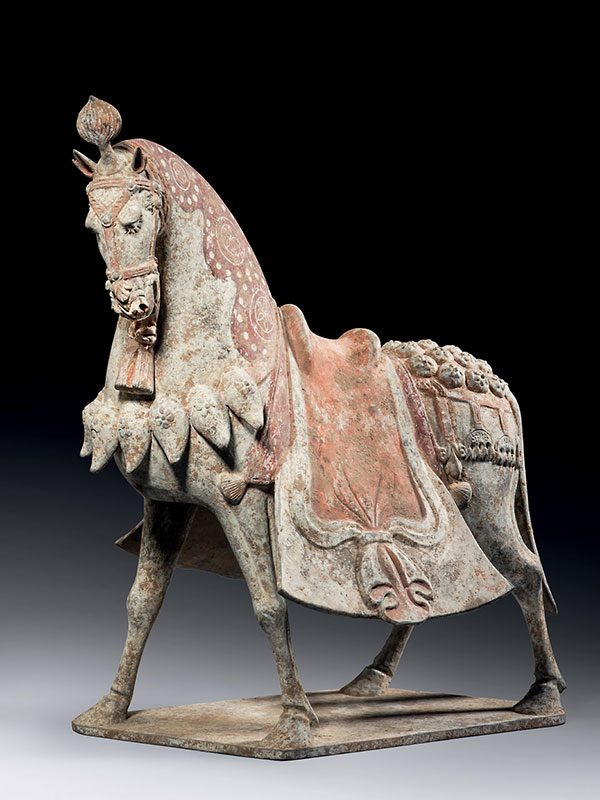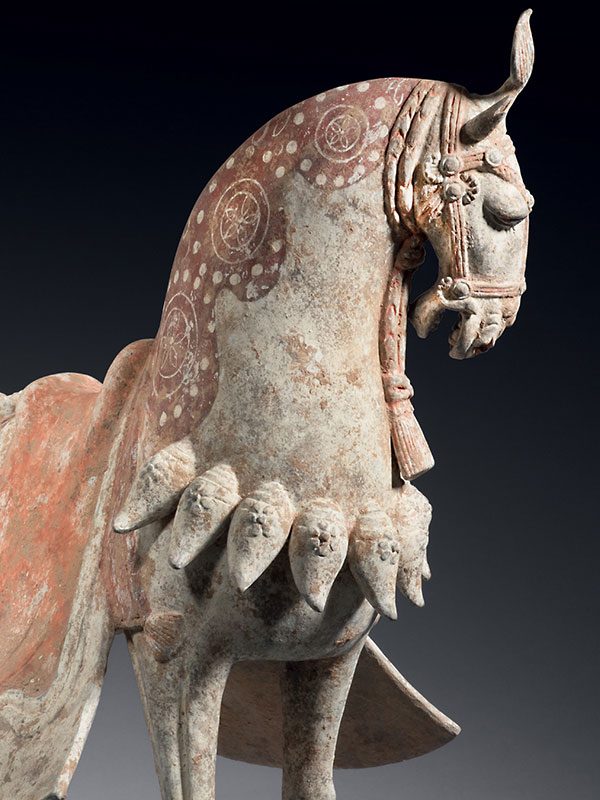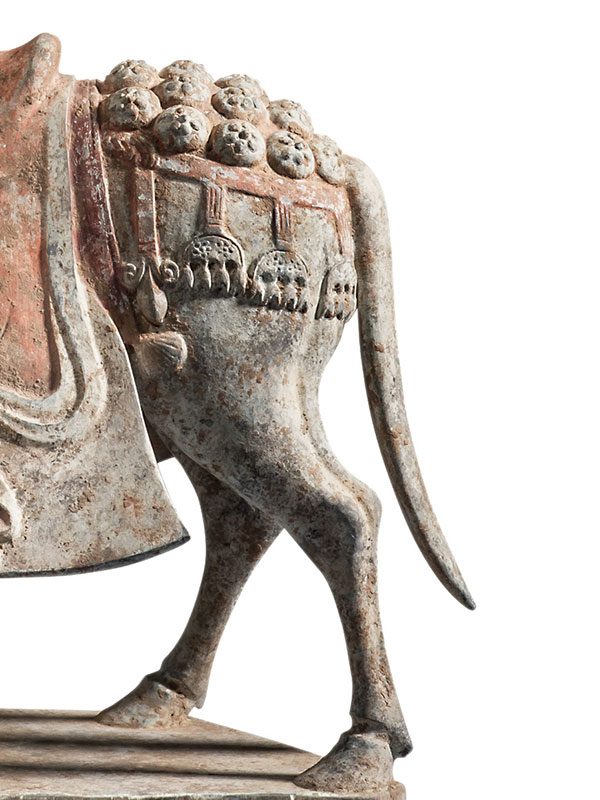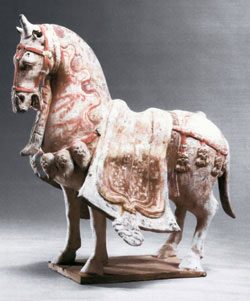Pottery caparisoned horse
A pottery model of horse, depicted striding, with the front right leg and the back right leg slightly forward. The legs are held together by a lozenge-shaped base. The horse has a gracefully arched neck and its well modelled head is tucked in towards the wide chest, which is decorated with a row of large conch-shells with raised florets, each of which has a moulded flower. The horse’s head is carefully modelled with an alert expression, pricked ears, flared nostrils, wide-open mouth and a horn-like hair finial. The head has an ornamental bridle and a double-plaited cord around the neck that extends into a tassel hanging under the chin. The saddle, which is arranged on a flared blanket, has a knotted saddlecloth thrown over it. The saddle is held in place with straps hung with tassels and linked over the horse’s hindquarters by a leather pad, which is ornamented with several rows of bosses. The saddlecloth is painted in red and orange. The long tail is combed straight down. The mane is arranged in waves to either side of the head and picked out in bright red pigment with roundel ornaments on a cream ground, which covers virtually the entire animal and the grey pottery underneath.
This finely modeled horse is amongst the best examples of this period. In general, horses of the Northern Wei period are characterised by their stiff legs, widely projecting trapezoid saddles, powerfully arched necks, broad chests and relatively small heads. After Emperor Xiao Wendi’s decree that moved the capital to Luoyang in 494 AD, the style of tomb sculptures altered abruptly, influenced by developments in painting in the southern courts.[1] Thus from the late Northern Wei period, horses became more naturalistic and more richly decorated, continuing into the Tang dynasty (618 – 906), reminiscent of styles then current in Central Asia and Persia. Horses of this type can be found from the late Northern Wei, then Eastern Wei (534 – 550) and to the Northern Qi (550 – 577) in tombs in Hebei and Shanxi province. A closely comparable pottery horse that shows the typical equine representations of the late Northern Wei period was unearthed from a tomb at Quyang.[2] Other Northern Wei pottery caparisoned horses of similar design are in the collection of the Rijksmuseum,[3] the Royal Ontario Museum,[4] and the Julius Eberhardt collection.[5] Elaborately caparisoned pottery horses also have been found in a number of Eastern Wei tombs, such as one recovered from the tomb of a princess of the Ruru nationality in Cixian, Hebei province and dated to 550 AD.[6] Three further comparable pottery horses, dated to the late Northern Wei to Eastern Wei dynasty, are illustrated by Victor Choi in Horses for Eternity.[7] A closely comparable Eastern Wei pottery horse with very similar decoration is in the Anthony M. Solomon collection exhibited at Harvard in 2002 (fig. 1).[8] A further comparable example, dated to the Northern Dynasties (439 – 581) was excavated from Hebei province in 1948 and is now in the collection of the National Museum of China.[9] The present horse is also remarkably similar to an example that was included in our 2018 catalogue.[10]
Provenance: private collection, Asia
- Choi, V. Horses for Eternity, Dragon Culture, Hong Kong, 2007, p. 124
- Kaogu, 1972, no. 5
- Jörg, C.J.A. and Campen, J. van, Chinese Ceramics\in the Collection of the Rijksmuseum, Amsterdam, the Ming and Qing Dynasties, no. 21, p. 46
- The Royal Ontario Museum online collection archive, http://collections.rom.on.ca/objects/337479/burial-figure-of-a-horse?ctx=a3a7e226-e661-401d-9f2f-74f9d.c55f438&idx=2
- Krahl, R. Sammlung Julius Eberhardt, Frühe chinesische Kunst/Early Chinese Art, Vienna, 1999, no. 115, p. 198
- Wenwu 1984:4, pl. V:2 and fig. 7:3
- Choi, V. op. cit. nos. 40-42, pp. 122-9
- Bower, V. L. From the Court to Caravan – Chinese Tomb Sculpture from the collection of Anthony M. Solomon, Harvard University Art Museums, Cambridge, 2002, no. 49, p. 133
- The National Museum of China online collection archive, http://www.chnmuseum.cn/tabid/212/Default.aspx?AntiqueLanguageID=769
- Ben Janssens Oriental Art catalogue 2018, pp. 10 – 13




